 |
Kotso Lodge HistoryIn the year 1915 an organization was established, by the Boy Scouts of America, that was intended to offer an opportunity to honor those who have best exemplified the ideals of scouting. This is a secret organization known as the Order of the Arrow and was first organized in Chisholm Trail Council at Camp Tonkawa in July, 1945, by Claude Willis. After the initial organization, the first two Scouts elected as candidates were Bob Haynie and Earl Gultar, Jr., both of Abilene. The Camp Tonkawa group is known as the Kotso Lodge Chapter of the Order of the Arrow. Its purpose is to recognize those campers, who best exemplify the Scout Oath and Law in their daily lives, and by such recognition cause others to conduct themselves in such a manner as to warrant recognition. The order of the Arrow further strives to promote a feeling of brotherhood and friendship among members of the lodge, thereby promoting unity within the Chisholm Trail Council.
The Order of the Arrow is the honor camper’s society at Camp Tonkawa. A small percent of the campers are selected each season for membership. Each member has proven himself to be an outstanding camper. The new members are Billy Stephenson, Walter Gordon, Danny Howell, Don Day, Dan Brown, Orin Newman, Bennie Bass, and Duane Boredook. Other members are Jerry Howell, Tony Willeke, Leonard Ehrler, Joe Cervanka, and Carl Fleming, Jr. George Foster, Jr., made a successful lodge chief and under his direction, the Kotso Lodge rapidly justified the recognition and praise that the Order of the Arrow was receiving. In 1947, Caldwell Beckham was elected as the new lodge chief, but Paul then immediately declared himself as lodge chief and gave Beckham a new title. This action, by the scout executive, was not legal and the Order of the Arrow became a political springboard for the scout executive until 1948. When Robert C. Claw became scout executive in August ,1948, one of his first actions was to turn the Order of the Arrow program back to the boys. McDaniel (Smokey) Ward was elected lodge chief to follow Caldwell Beckham. Ward was an excellent chief, however, part of his administration was under the handicapped conditions forced upon the lodge by Paul Ireland. Troy Boone, the present lodge chief was elected to succeed McDaniel Ward. Troy has worked with a free hand in promoting the Order of the Arrow, and has received help and encouragement form the council office. Camp Tonkawa is now and Order of the Arrow operated camp.
Projects at Camp TonkawaThe original council fire ring was located on the hill, near the present flagpole. (Elizabeth Smith's note: This was behind the present Sunday night campfire ring.) In 1946, members of the Order of the Arrow cleared a place south of the mess hall (now the Trading Post) near the old dirt swimming pool, for a council fire ring.
The large observation tower near the swimming pool was built by member of the Order of the Arrow. Many other needed improvements can be found in Camp Tonkawa that were made by members of the Order of the Arrow. During their Ordeal weekends, Brotherhood weekends and other special "work days," the members of the lodge worked on whatever was needed to be done to help make the camp a better place to camp. Thousands of manhours have been given to the camp over the years. "Calling Out" Ceremony"Tap Out" Ceremonies"In the early days of the Lodge, out tap out ceremonies were held on Thursdays during summer camp at a location West of the rifle range and across the highway. All of the Scouts in camp and visitors would assemble at the parking lot and were led past the rifle range to the barbed wire fence which was held open by two brothers and then lined up on the side of the highway until Mr. Ed Burnam felt that there was no traffic. They would then cross the highway together to the other side and then over another barbed wire fence to the ring. I always feared a semi or drunk on the way to the State Park would someday wipe us all out, but the ring was so perfect that we felt it was worth the changes we took. "The ring was surrounded by high bluffs which offered all kinds of opportunities. Normally, the dances involved would file off the hills down to the ring carrying torches to light the way. Any member of the Order who had a 'costume' could participate in the dancing and normally the dances consisted of toe heel serpentine with several free steps thrown in. Our 'costumes' normally consisted of breech clout, moxicans, bells, and some sort of head dress. There were very few leggens. Sometimes a Brother would perfect a specialty dance such as Jon King's legendary Eagle dance and hoop dance or challenge dance. "One time, someone thought that we should light the fire with a flaming arrow, so he rigged up a roll of toilet paper, soaked it in diesel, and strung it on some piano wire stretched up the bluffs to a mesquite tree there. The last few feet of wire next to the fire was substituted with twine so that after the fire lit, it would burn the twine and the wire should snake harmlessly back up the hill and allow us to dance. When the time came, the Chief called upon the spirits to light our council fire and a Brother lit the toilet paper, drew his bow, and allowed the paper to sail down the wire to the fire. When it hit, it almost destroyed the fire lay with its impact and then when the string burned, our piano wire twanged up the bluff almost cutting the dancers down. It was a beautiful idea, but needed some perfecting. "The only problem with this site, other than being over the highway, was that when we weren't using it cattle grazed over it making our dancing stage rough and hard to work with. Also, guests and dancers found that they had to clean their shoes afterwards. We later lit the fire with sandpaper and matches, chemicals, and finally came upon the battery with wires on each side of a few matches which worked most of the time. Still, we had to always have a tourch bearer handy in case the 'spirits weren't with us.' "Later, when the tap our was held where the ring is today, we had the bright idea to have the winds answer the call with sparklers attached to arrow to be fired over the ring. That was really impressive until one night a sparkler was fired short and as we were watching, it went out and everyone fell silent wondering who had been hit. Later, it was found a few feet behind the guest and that ended that bright idea. "A book could (and probably should) be written about other close calls, but there is so much more to tell, I will go on. "As I mentioned earlier, tap outs were held on Thursday nights with work day on Friday, and the candidates invited back after summer camp for the final Ordeal. It did interfere with the Friday camp activities such as boards of review where they were taken off of silence, but it did allow the rest of the camp to watch the work day. Silence was strickly enforce and ti was rare for anyone to break silence during the Ordeal. If a candidate had a question or needed to say something, he would kneel in front of a Brother and the Brother would ask questions until the candidate would stand.
Almost Blackballed at ConclaveTime Capsule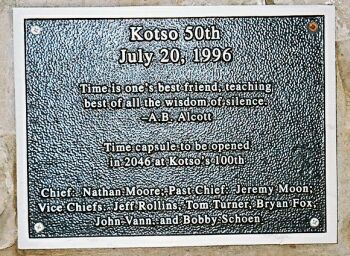 A
time capsule was placed at Camp Tonkawa as part of
the 50th Anniversary
Celebration of the Kotso Lodge. The plaque
read "Kotso 50th - July
20, 1996 - Time is one's best friend, teaching best
of all the wisdom of
silence.- A. B. Alcott. Time capsule to be
opened in 2046 at Kotso's
100th. Chief: Nathan Moore; Past Chief: Jeremy
Moon; Vice Chiefs:
Jeff Rollins, Tom Turner, Bryan Fox, John Vann and
Bobby Schoen." A
time capsule was placed at Camp Tonkawa as part of
the 50th Anniversary
Celebration of the Kotso Lodge. The plaque
read "Kotso 50th - July
20, 1996 - Time is one's best friend, teaching best
of all the wisdom of
silence.- A. B. Alcott. Time capsule to be
opened in 2046 at Kotso's
100th. Chief: Nathan Moore; Past Chief: Jeremy
Moon; Vice Chiefs:
Jeff Rollins, Tom Turner, Bryan Fox, John Vann and
Bobby Schoen."
The members of the Order of the Arrow study Indian traditions. The organization follows a pattern copied from the Indians. The lodge has a traveling library of books dealing with Indian dancing an traditions. Each lodge member makes and Indian outfit of his own design. He learns the Indian dance steps and through the year he enjoys meeting the other fellows, around a camp fire, and practicing the Indian dances. Each new member selects, for himself, an Indian name chosen because of some outstanding event that happened while he was in camp. *The original book said “costumes” but Kotso Lodge deems it politically incorrect therefore the term "outfit" has been used. First Lodge Patch
"In the summer of 1956, we formed up a small contingent to attend the Area Conclave at Camp Karankawa just outside of Corpus Christi. Mr. Jack Lanier, now deceased but a longtime Scouter (I served as Allow at his Vigil Honor ceremony), drove a borrowed school bus (yellow with Wylie School District painted on the side) loaded with some fifteen of us Kotso Lodge Arrowmen. One of the many things we were impressed with at that conclave --- the first such event that Kotso Lodge had ever attended in Area 9-D --- was the various lodges and their flap-patches. Karankawa, Aina Topa Hutsi, several lodges there had more than just the (our) usual fare: the OA button ribbon medallion, and while a lot simpler than what we have today, those flap 'things' were just so beautiful! "We just had to have one for Kotso! "So, the three of got to work after we got back home from the trip. "Yes, the design was literally formed by a committee of three. The buffalo (Mike like to call it a Bison) superimposed over the red arrow element (several comments about which direction it should point) and the background material of the patch itself (we wanted it to match our regular Camp Tonkawa summer camp patch except instead of the black thread embroidered edge like the camp patch, we wanted it to be red for the flap-patch) with the WWW's inserted along with Chisholm Trail Council and "Kotso," we had our patch! The second year we found out that we need to add the lodge number which we simply overlaid on Mike's Bison." The 30th Anniversary pocket flap and jacket patches were designed by Charles R. Moon (Vigil '91) and Mr. Swinson. Dance Team OrganizedKotso Lodge annually presents the Lanier Trophy to an outstanding member of the Kotso Dance Team. This trophy is named for John H.and Mike Lanier who were instrumental to beginning and building the dance team. John H. Lanier was a Scoutmaster of Troop 13 and had organized an Indian Dance Team. This troop team put on early dances at the Thursday evening campfires to assist the Lodge with its "calling out" ceremony until such time as the Lodge developed its own dancers under the direction of John H. Lanier. Brotherhood Requirements"Our Brotherhood requirements were to work twenty hours for the Council during the year and then come to Tonkawa for the Brotherhood ceremonies. To the Abilene members, it was a simple task and some even got their twenty hours mowing the office lawn, but we from the Northern District had to spend a few week-ends at camp during the year to get the hours. Today's method of having everyone show up for a Brotherhood week-end is much beter and allows so much more to be done, not to mention the joy of working with other Brothers for the benefit of Scouting and the Order." E. Urner Goodman Camping AwardNational and Area/Section Positions and AwardsHeld by Kotso Arrowmen
Lodge ChiefsThe
most important youth leader of a lodge is the
Lodge Chief. They are
responsible foring seeing that the Lodge runs
1945
- George Foster, Jr. (7/45-12/45)
Lodge AdvisersOver the years many great Scouters served as Adviser for Kotso Lodge. They have given of their time, their talents and their knowledge to guide the officers of the Lodge to insure that the very best program of cheerful service was rendered to others. A list of known advisers and when they served includes: First
Adviser - Claude "Skipper" Willis
First Vigil CeremonyThe first candidates were Joe Ed Burnam, Coleman, youth, and adults, Henry H. McGinty, Abilene; H. D. Norris, Sweetwater; and J. Ben Sellers, Camp Ranger, Camp Tonkawa. (Note: There is some disagreement as to who exactly received the Vigil Honor first. One letter from Wallar Overton in 1995, stated that Ed Burnam and Ben Sellers went to another lodge and received their Vigil, and that these two were actually responsible for bringing the Vigil Honor to the Kotso Lodge.) Here is what he wrote: "The Vigil honor was brought into our lodge by Ed Burnam and a few of the active adult leaders. I believe it was Ben Sellers (camp ranger), Skipper Willis, and someone else. They went to another Council and received the Vigil and then returned to bring it into the Kotso Lodge. My brother Bill Overton and Joe Ed Burnam were in the first group of boy Vigils and I was in the second group. During the Vigil ceremonies, we were asked to meditate over our Indian name and the spirits would help us find it. I remembers watching a stink bug crawl into my fire and throught of 'Flaming Stink Bug.' Later, an armadillo started rooting under my bedrool and I thought 'Rooting Armadillo.' Finally, after watching an American launched satelite, 'Echo 1,' all night as it passed over Tonkawa, I found my Indian name of 'Silent Echo.' I understand that today, your Indian name is assigned to you, but I will always remember finding mine. A year or two later, we were having the Vigil Ceremonies and it really poured rain on the candidates, and, almost to a man, they selected 'Rain in the Face.' " The second Vigil induction was held October 27, 1957, and honored Edwin Burnam, Coleman, Camp Director of summer camp for several years; Claude "Skipper" Willis, Abilene, Waterfront Director of summer camps for several years; and one youth, name unknown. The Vigil Honor is the highest honor that the Order of the Arrow can bestow upon its members for service above self to their lodge and local council. The first person to receive the Vigil Honor in the Order of the Arrow was its founder E. Urner Goodman, who received this honor in 1915. Here is a partial list of Vigil Honor members inducted in Kotso Lodge. 1952
- James Culwell
Founder's Award1983 -
Kevin Richie, Thomas
G. Thompson
Noe Award1997
- David D. Andrews, Jr.
"Marty" Award1995
- Martin Calvert
Lanier Award1990 -
John Lanier
Matthew Noland Award1995
- Nathan Moore
Section Conclaves1960 -
Area 9-D, Camp Tonkawa
Last Officers of the Lodge - 2003Vice Chief of Finance - Andy Shawhan Vice Chief of Service - Karey Kennedy Vice Chief of Indian Affairs - Jermy Corley Vice Chief of Communications - Chris Brooks Vice Chief of Camp Promotions and Unit Elections - Dustin Corley Vice Chief of OA Representatives - Robert Yost Secretary - Austin Alexander Lodge Adviser - Aivars Jurkis Staff Adviser - Jeremy Moon Newsletters The Kotso Lodge newsletter, The Buffalo Bull, from January 2001 to November 2003, is no longer available on the internet. We want to thank Matthew Fenner, Vice-Chief of Service, and Dr. Joe B. Alexander, Adviser, Kotso Lodge, for providing us with this information on the Lodge. Part of this story was taken from Claude "Skip" Willis' book "The History of Chisholm Trail Council, Boy Scouts of America" Other information was taken from the 50th Anniversary booklet, 1995, edited by Elizabeth Smith. We know there might be some errors in our story but this is the best information we have at this time. Also thanks to Aivars Jurkis for the names we have in the Vigil Honor list. Last
Updated: February 3, 2025
|
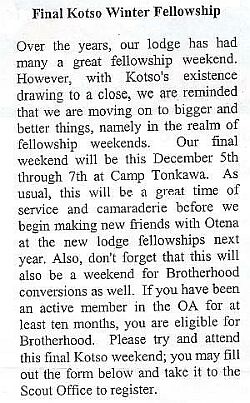 The
service crew, serving Camp Tonkawa summer camp in
1945, made up the first
Order of the Arrow group. An organization was
started with George Foster,
Jr., acting as lodge chief and Claude Willis
serving as advisor. The first
two boys chosen for the new organization were Bob
Eaynie and Earl Ouitar,
Jr., both of Abilene. The only time the Order of
the Arrow accepts new
members is in summer camp. A boy can not join
without invitation, but must
be chosen by his fellow campers to be honored by
membership. From the humble
beginning in 1945, the Order of the Arrow began to
expand. The editor of
the Coleman Democrat Voice in 1945 stated in
headlines that eight Coleman
County Boy Scouts had been chosen for membership
in the Order of the Arrow.
The
service crew, serving Camp Tonkawa summer camp in
1945, made up the first
Order of the Arrow group. An organization was
started with George Foster,
Jr., acting as lodge chief and Claude Willis
serving as advisor. The first
two boys chosen for the new organization were Bob
Eaynie and Earl Ouitar,
Jr., both of Abilene. The only time the Order of
the Arrow accepts new
members is in summer camp. A boy can not join
without invitation, but must
be chosen by his fellow campers to be honored by
membership. From the humble
beginning in 1945, the Order of the Arrow began to
expand. The editor of
the Coleman Democrat Voice in 1945 stated in
headlines that eight Coleman
County Boy Scouts had been chosen for membership
in the Order of the Arrow.
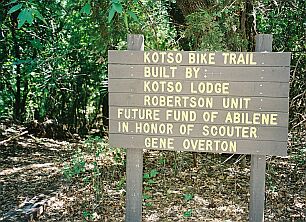
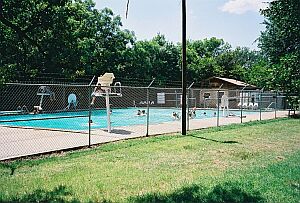 During
the last two weeks of the 1952 summer camp, the
members of the Order of
the Arrow moved the council fire ring back to the
hill, and a short distance
west of the flagpole. Members of the Order of the
Arrow built the large
observation tower near the swimming pool.
During
the last two weeks of the 1952 summer camp, the
members of the Order of
the Arrow moved the council fire ring back to the
hill, and a short distance
west of the flagpole. Members of the Order of the
Arrow built the large
observation tower near the swimming pool.
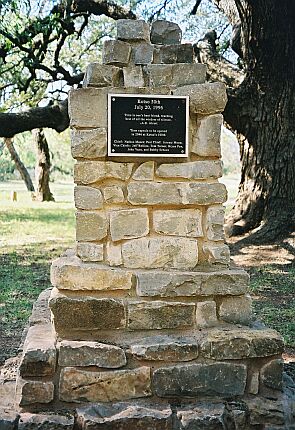 "---I
remember Dan Griffith had completed his work day
without breaking silence
and we allowed the candidates to swim before
getting dressed for supper.
Dan was diving off the board when he slipped and
yelled as he fell of of
the side of the board. You could see him
trying to tay under rather
than have to answer for breaking silence.
Normally, candidates tried
very hard to keep the silence, but sometimes we
would have one who jsut
couldn't keep quiet. The normal procedure
was to warn him once an
dthen either place a smooth pebble in his mouth
each time he broke silence
or place a stick in his mouth to remind him of his
obligation.
"---I
remember Dan Griffith had completed his work day
without breaking silence
and we allowed the candidates to swim before
getting dressed for supper.
Dan was diving off the board when he slipped and
yelled as he fell of of
the side of the board. You could see him
trying to tay under rather
than have to answer for breaking silence.
Normally, candidates tried
very hard to keep the silence, but sometimes we
would have one who jsut
couldn't keep quiet. The normal procedure
was to warn him once an
dthen either place a smooth pebble in his mouth
each time he broke silence
or place a stick in his mouth to remind him of his
obligation.
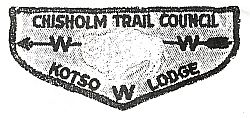 "...
three of us - Mike Bonine, Jon King, and Dow
Patterson, while over at Mike's
upstairs (over-the-garage) bedroom designed the
first Kotso patch."
Here is his story:
"...
three of us - Mike Bonine, Jon King, and Dow
Patterson, while over at Mike's
upstairs (over-the-garage) bedroom designed the
first Kotso patch."
Here is his story:
